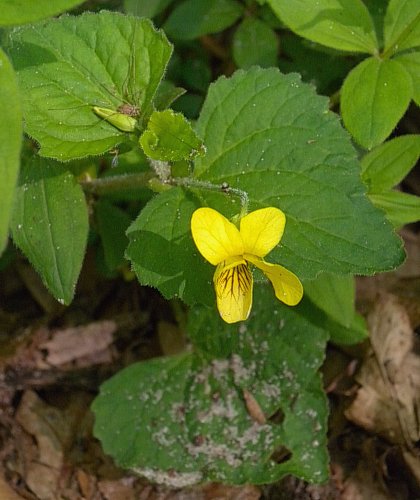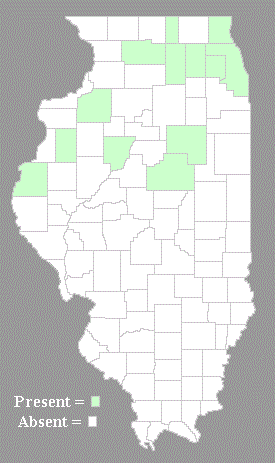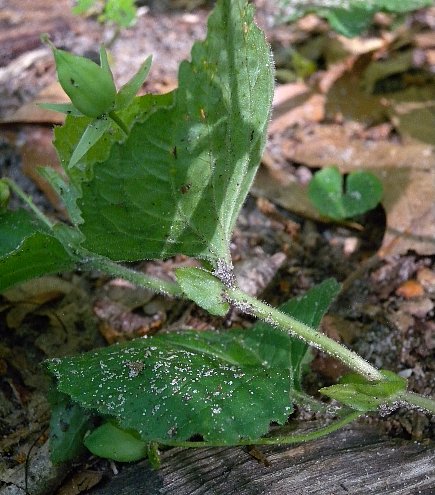
Individual flowers are produced from the axils of alternate leaves. Each flower spans about ¾" across, consisting of 5 yellow petals, 5 light green sepals, 5 inserted stamens, and a pistil with an inserted style. Branched brownish purple veins occur along the lowest petal and, to a much lesser extent, the 2 lower lateral petals. At the bases of the 2 lower lateral petals, there are small tufts of hair. The lowest petal has a nectar spur that is short and blunt. The sepals are shorter than the petals, linear-lanceolate in shape, and glabrous. The slender pedicels of the flowers are 2-8" long, light green, pubescent, and ascending. The tips of the pedicels are curved, causing the flowers to nod partially. Toward the middle of each pedicel, there is a pair of tiny bractlets that are about 2 mm. long, light green, and linear-lanceolate in shape. The blooming period occurs from mid- to late spring, lasting about 1-1½ months. The flowers are often slightly fragrant. After the flowers with showy petals have finished blooming, cleistogamous flowers without petals are produced. Fertile flowers of both types are replaced by seed capsules about ½" long that are ovoid, bluntly 3-angled, and either glabrous or
 pubescent. Immature capsules
are light green, but they later turn brown and split open into 3 parts,
ejecting their seeds. The seeds are about 2.0-2.5 mm. long,
ovoid-globoid in shape, slightly flattened, and tan-colored to brown.
Each seed
has a small oily appendage. The root system is rhizomatous and fibrous.
The clonal plants are occasionally produced from the rhizomes.
pubescent. Immature capsules
are light green, but they later turn brown and split open into 3 parts,
ejecting their seeds. The seeds are about 2.0-2.5 mm. long,
ovoid-globoid in shape, slightly flattened, and tan-colored to brown.
Each seed
has a small oily appendage. The root system is rhizomatous and fibrous.
The clonal plants are occasionally produced from the rhizomes.Cultivation: The preference is partial sun to light shade, moist to dry-mesic conditions, and a relatively loose soil containing loam or sandy loam with some decaying organic matter (e.g., fallen leaves). This violet doesn't tolerate mowing. It is able to flourish in areas that have pine needles as ground litter to a greater extent than many other plants.
Range & Habitat: The native Hairy Yellow Violet (Viola pubescens pubescens) is occasional in northern Illinois, while in the rest of the state it is apparently absent. It is less common within the state than another variety of this species, Smooth Yellow Violet (Viola pubescens eriocarpa). Habitats include mesic to upland woodlands, sandy woodlands, forested sand dunes, and areas along woodland paths.
Faunal Associations: The flowers are cross-pollinated primarily by bees, including mason bees (Osmia spp.), little carpenter bees (Ceratina spp.), Anthophorid bees, Halictid bees, and Andrenid bees. Other insects that visit the flowers include bee flies (Bombylius major), small butterflies, and skippers. Bees suck nectar and collect pollen, while other floral visitors suck nectar. Some insects feed destructively on the foliage, plant juices, and other parts of violets (Viola spp.). These insect feeders include Neotoxoptera violae (Violet Aphid), Ametastegia pallipes (Violet Sawfly), Odontothrips pictipennis (a thrips), caterpillars of the moth Elaphria grata (Grateful Midget), and caterpillars of various Fritillary butterflies (Boloria spp., Speyeria spp.). Because of their oily appendages, the seeds are spread to new areas by ants. Among vertebrate animals, the seeds of violets are consumed by such birds as the Mourning Dove, Ruffed Grouse, Wild Turkey, and Slate-Colored Junco; and by such small rodents as the Pine Mouse and White-Footed Mouse (Martin et al., 1951/1961). The leaves and stems of these plants are eaten by the Cottontail Rabbit, Eastern Chipmunk, and Wood Turtle (Martin et al., 1951/1961; Wrazen & Svendsen, 1978; Ernst et al., 1994). White-Tailed Deer browse on the foliage very sparingly.

Photographic Location: A forested sand dune at the Indiana Dunes State Park in NW Indiana.
Comments: Because Hairy Yellow Violet (Viola pubescens pubescens) and Smooth Yellow Violet (Viola pubescens eriocarpa) intergrade, they are considered different varieties of the same species. Hairy Yellow Violet can be identified by the conspicuous pubescence on its stems, pedicels, and leaf undersides, while the stems, pedicels, and leaf undersides of Smooth Yellow Violet are slightly short-pubescent to nearly glabrous. Hairy Yellow Violet also differs from the latter variety by producing fewer basal leaves and leafy stems per rootstalk, and its stipules are usually larger in size and more rounded toward their tips. Plants with glabrous seed capsules have been classified as Viola pubescens peckii (Peck's Yellow Violet), but most botanists don't recognize this variety at the present time. Another common name of Viola pubescens pubescens is Downy Yellow Violet.